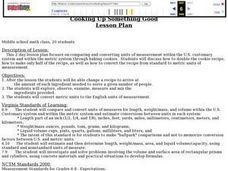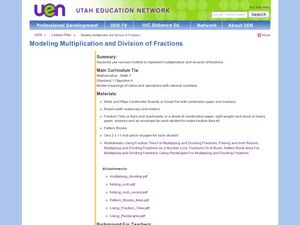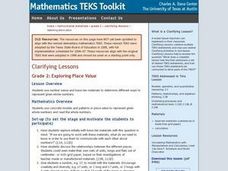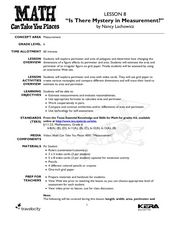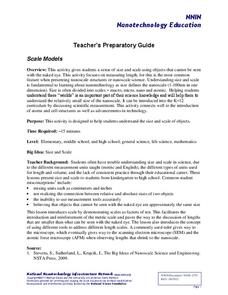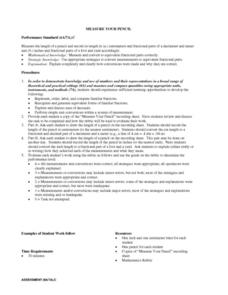PBS
Frame Yourself: Area and Perimeter
Elementary schoolers are arranged in pairs and view the video Math Works: Measurement: The Difference Between Perimeter and Area. They discuss any prior knowledge they have of the term perimeter and then brainstorm together what the...
Curated OER
Measure Mania
Groups of learners rotate through five classroom stations to estimate, measure, and record volume, length, weight, mass, and area using both customary and metric measure. They evaluate their data to determine how close their estimates...
Curated OER
Cooking Up Something Good
Students compare and convert units of measurement within the United States customary system and within the metric system by baking cookies. Students discuss how to double the cookie recipe, how to make only half of the recipe, and how to...
Curated OER
Modeling Multiplication and Division of Fractions
Create models to demonstrate multiplication and division of fractions. Using fraction tiles to model fractions, pupils explore fractions on a ruler and use pattern blocks to multiply and divide. They also create number lines with fractions.
Curated OER
Grade 2: Exploring Place Value
Creative problem solving is fun and helps kids conceptualize content. They use grid paper, manilla paper, and markers to cut, draw, and show given double-digit numbers as many ways as they can.
Curated OER
Is There Mystery in Measurement?
Investigate perimeter and area of polygons! In this measurement lesson, learners use index cards to create rectangles and trace their hand to estimate its area and perimeter.
Agriculture in the Classroom
Seed Match
Using this resource, your team of green thumbs discuss why plants are a part of a healthy diet and the different ways they are used in daily life. They then observe the characteristics of different seed as they attempt to match...
Exploratorium
Eddy Currents
Make electromagnetic eddy currents evident with this demonstration. You will need to gather a few materials from the local hardware store and a strong neodymium magnet, but the visual value is well worthwhile.
Exploratorium
Corner Reflector
If you set up a triad of mirrors into a corner figuration, they act as a kaleidoscope, bouncing light waves back and forth indefinitely, changing the light that your eyes perceive. Although the materials required are very specific and...
Exploratorium
Marshmallow Puff Tube
Let physical science stars experience Newton's first law of motion by blowing marshmallows out of cardboard tubes! Using different lengths of tubing, they find that more force is needed to overcome increasing friction, and they have a...
National Nanotechnology Infrastructure Network
Scale Models
With instructions to adapt the activities for any grade K-12, any teacher can incorporate the concept of scale into the classroom with a simple, yet effective lesson.
Curated OER
Who Has Denser Fur?
In this mathematics worksheet, learners identify and solve who has the denser fur, either the Sumatran tiger or the sea otter. They calculate the number of hairs for each per inch or per meters and compare them.
Curated OER
Measuring Units and Tools reteach 18.7
For this identifying used to measure worksheet, students review standard and metric units of measure, circle the picture of the unit used to measure and the picture of the correct tool required. Students circle four answers.
Curated OER
Fractions: word problems
In this fractions worksheet, students solve word problems containing fraction problems of least to greatest, measurements, class counting, and more. Students complete 8 problems total.
Curated OER
Measure Your Pencil
Fifth graders use concepts of measurement to record the dimensions of a pencil. The unit of a pencil is used to compare it as part of a larger measurement like a yard. Students convert equivalent fractions accurately. Students also...
Exploratorium
Bubble Tray
Create jumbo bubbles and use them to teach about surface tension or interference, perfect for a physical science lesson on light or molecular attraction.
Curated OER
Frost Depth Study
Students complete activities to study the frost and frost depth. For this frost study lesson, students use frost tubes to study and measure the frost at their school. Students measure the frost in the tube and enter their data online to...
Curated OER
Measuring in Inches
Third graders will sing 2 songs that are written and played by the teacher and relate to the task of measuring.They recognize and pick up a 1-foot standard ruler and be able to identify the marks on the ruler, including inch and parts of...
Curated OER
Using Multiplication to Solve Word Problems
Learners explore math functions by solving word problems in class. In this multiplication lesson, students utilize colored cubes and base blocks to visualize multiplication problems. Learners identify the multiplication values within...
Curated OER
Converting among Units
In this conversion instructional activity, student use the factor-label method or unit analysis method to convert given measurements from one unit to another unit.
Curated OER
Conversions: Metrics Made Easy
Students, in groups, measure and record each other's height. They identify measurement conversion methods and use online resources to convert measured heights to multiple systems.
Mrs. Glosser's Math Goodies
Circumference & Area Worksheet 1
Don't stress about creating your own problems and use this series of circumference and area worksheets. The problems ask pupil to plug diameter and radius into the formula to solve for area or circumference. The problems also have...
Curated OER
Everyday Mathematics at Home
Send this information home with your young learners. Adults, siblings, or friends can help youngsters learn how to measure! This gives basic tips and suggests having the child draw a series of lines, and then use their 10-centimeter...
Curated OER
Indirect Length Word Problems - Matching Worksheet
First graders demonstrate their ability to compare the lengths of three objects and determine which is the longest or shortest. Pupils match the correct answer to each of the seven story problems. All lengths are expressed in...


